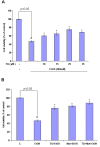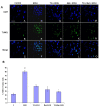Neuroprotection with metformin and thymoquinone against ethanol-induced apoptotic neurodegeneration in prenatal rat cortical neurons
- PMID: 22260211
- PMCID: PMC3317821
- DOI: 10.1186/1471-2202-13-11
Neuroprotection with metformin and thymoquinone against ethanol-induced apoptotic neurodegeneration in prenatal rat cortical neurons
Abstract
Background: Exposure to ethanol during early development triggers severe neuronal death by activating multiple stress pathways and causes neurological disorders, such as fetal alcohol effects or fetal alcohol syndrome. This study investigated the effect of ethanol on intracellular events that predispose developing neurons for apoptosis via calcium-mediated signaling. Although the underlying molecular mechanisms of ethanol neurotoxicity are not completely determined, mitochondrial dysfunction, altered calcium homeostasis and apoptosis-related proteins have been implicated in ethanol neurotoxicity. The present study was designed to evaluate the neuroprotective mechanisms of metformin (Met) and thymoquinone (TQ) during ethanol toxicity in rat prenatal cortical neurons at gestational day (GD) 17.5.
Results: We found that Met and TQ, separately and synergistically, increased cell viability after ethanol (100 mM) exposure for 12 hours and attenuated the elevation of cytosolic free calcium [Ca²⁺]c. Furthermore, Met and TQ maintained normal physiological mitochondrial transmembrane potential (ΔψM), which is typically lowered by ethanol exposure. Increased cytosolic free [Ca²⁺]c and lowered mitochondrial transmembrane potential after ethanol exposure significantly decreased the expression of a key anti-apoptotic protein (Bcl-2), increased expression of Bax, and stimulated the release of cytochrome-c from mitochondria. Met and TQ treatment inhibited the apoptotic cascade by increasing Bcl-2 expression. These compounds also repressed the activation of caspase-9 and caspase-3 and reduced the cleavage of PARP-1. Morphological conformation of cell death was assessed by TUNEL, Fluoro-Jade-B, and PI staining. These staining methods demonstrated more cell death after ethanol treatment, while Met, TQ or Met plus TQ prevented ethanol-induced apoptotic cell death.
Conclusion: These findings suggested that Met and TQ are strong protective agents against ethanol-induced neuronal apoptosis in primary rat cortical neurons. The collective data demonstrated that Met and TQ have the potential to ameliorate ethanol neurotoxicity and revealed a possible protective target mechanism for the damaging effects of ethanol during early brain development.
Figures





Similar articles
-
Protective effect of pyruvate against ethanol-induced apoptotic neurodegeneration in the developing rat brain.Neuropharmacology. 2011 Dec;61(8):1248-55. doi: 10.1016/j.neuropharm.2011.06.031. Epub 2011 Jul 23. Neuropharmacology. 2011. PMID: 21803053
-
Cadmium-induced apoptosis in primary rat cerebral cortical neurons culture is mediated by a calcium signaling pathway.PLoS One. 2013 May 31;8(5):e64330. doi: 10.1371/journal.pone.0064330. Print 2013. PLoS One. 2013. PMID: 23741317 Free PMC article.
-
Neuroprotection by Vitamin C Against Ethanol-Induced Neuroinflammation Associated Neurodegeneration in the Developing Rat Brain.CNS Neurol Disord Drug Targets. 2016;15(3):360-70. doi: 10.2174/1871527315666151110130139. CNS Neurol Disord Drug Targets. 2016. PMID: 26831257
-
The Mechanistic Role of Thymoquinone in Parkinson's Disease: Focus on Neuroprotection in Pre-Clinical Studies.Curr Mol Pharmacol. 2021;14(6):1083-1092. doi: 10.2174/1874467214666210105140944. Curr Mol Pharmacol. 2021. PMID: 33402092 Review.
-
Is metformin neuroprotective against diabetes mellitus-induced neurodegeneration? An updated graphical review of molecular basis.Pharmacol Rep. 2023 Jun;75(3):511-543. doi: 10.1007/s43440-023-00469-1. Epub 2023 Apr 24. Pharmacol Rep. 2023. PMID: 37093496 Review.
Cited by
-
Anthocyanins protect against ethanol-induced neuronal apoptosis via GABAB1 receptors intracellular signaling in prenatal rat hippocampal neurons.Mol Neurobiol. 2013 Aug;48(1):257-69. doi: 10.1007/s12035-013-8458-y. Epub 2013 May 4. Mol Neurobiol. 2013. PMID: 23645118
-
Neurotoxic Agent-Induced Injury in Neurodegenerative Disease Model: Focus on Involvement of Glutamate Receptors.Front Mol Neurosci. 2018 Aug 29;11:307. doi: 10.3389/fnmol.2018.00307. eCollection 2018. Front Mol Neurosci. 2018. PMID: 30210294 Free PMC article. Review.
-
Metformin from mother to unborn child - Are there unwarranted effects?EBioMedicine. 2018 Sep;35:394-404. doi: 10.1016/j.ebiom.2018.08.047. Epub 2018 Aug 27. EBioMedicine. 2018. PMID: 30166273 Free PMC article. Review.
-
Involvement of AMP-activated protein kinase in neuroinflammation and neurodegeneration in the adult and developing brain.Int J Dev Neurosci. 2019 Oct;77:48-59. doi: 10.1016/j.ijdevneu.2019.01.007. Epub 2019 Jan 29. Int J Dev Neurosci. 2019. PMID: 30707928 Free PMC article. Review.
-
Neuromodulatory Effect of Thymoquinone in Attenuating Glutamate-Mediated Neurotoxicity Targeting the Amyloidogenic and Apoptotic Pathways.Front Neurol. 2018 Apr 13;9:236. doi: 10.3389/fneur.2018.00236. eCollection 2018. Front Neurol. 2018. PMID: 29706929 Free PMC article.
References
-
- Jones KL, Smith DW, Ulleland CN, Streissguth AP. Pattern of malformation in offspring of chronic alcoholic mothers. Lancet. 1973;1:1267–1271. - PubMed
Publication types
MeSH terms
Substances
LinkOut - more resources
Full Text Sources
Other Literature Sources
Research Materials
Miscellaneous

